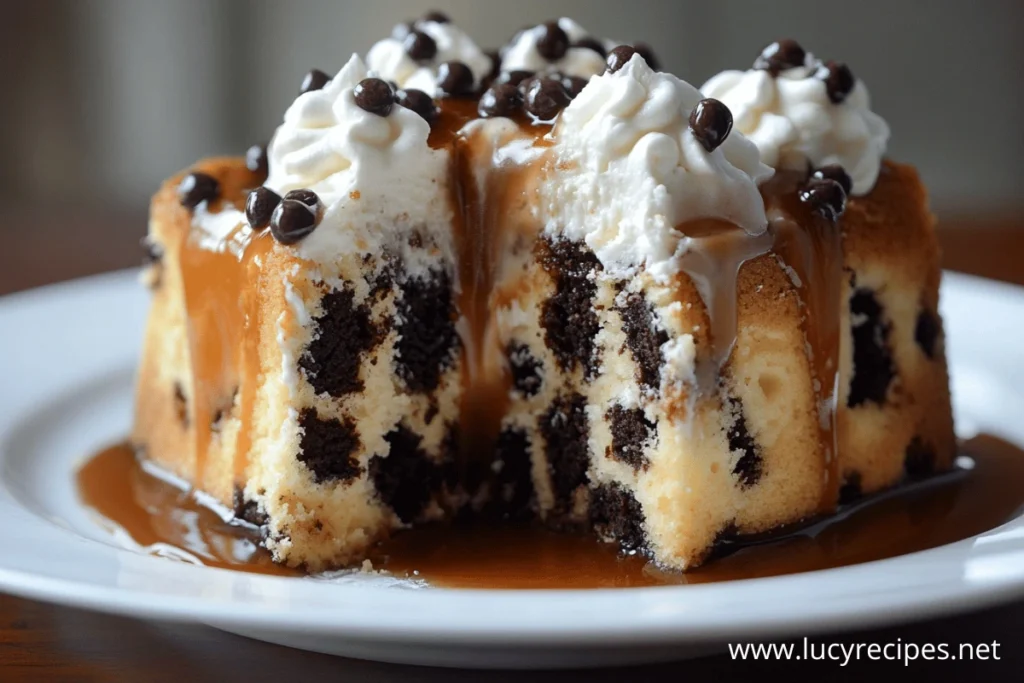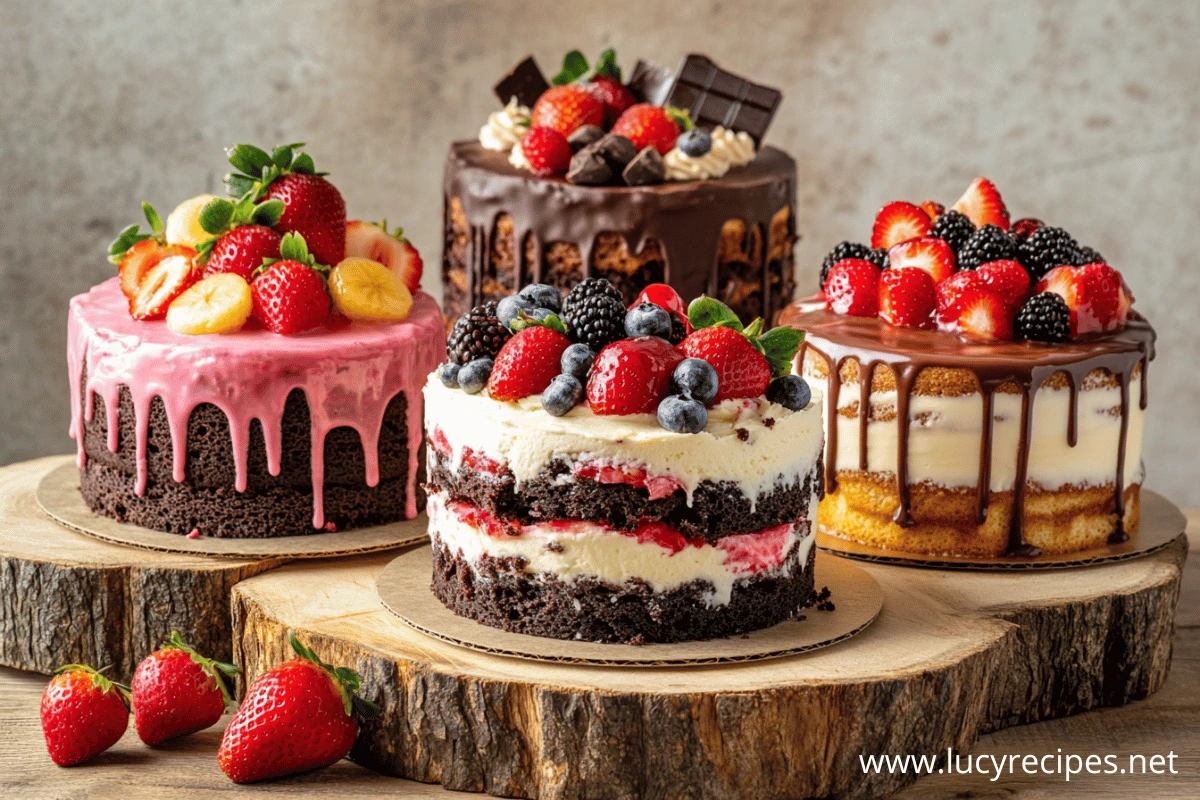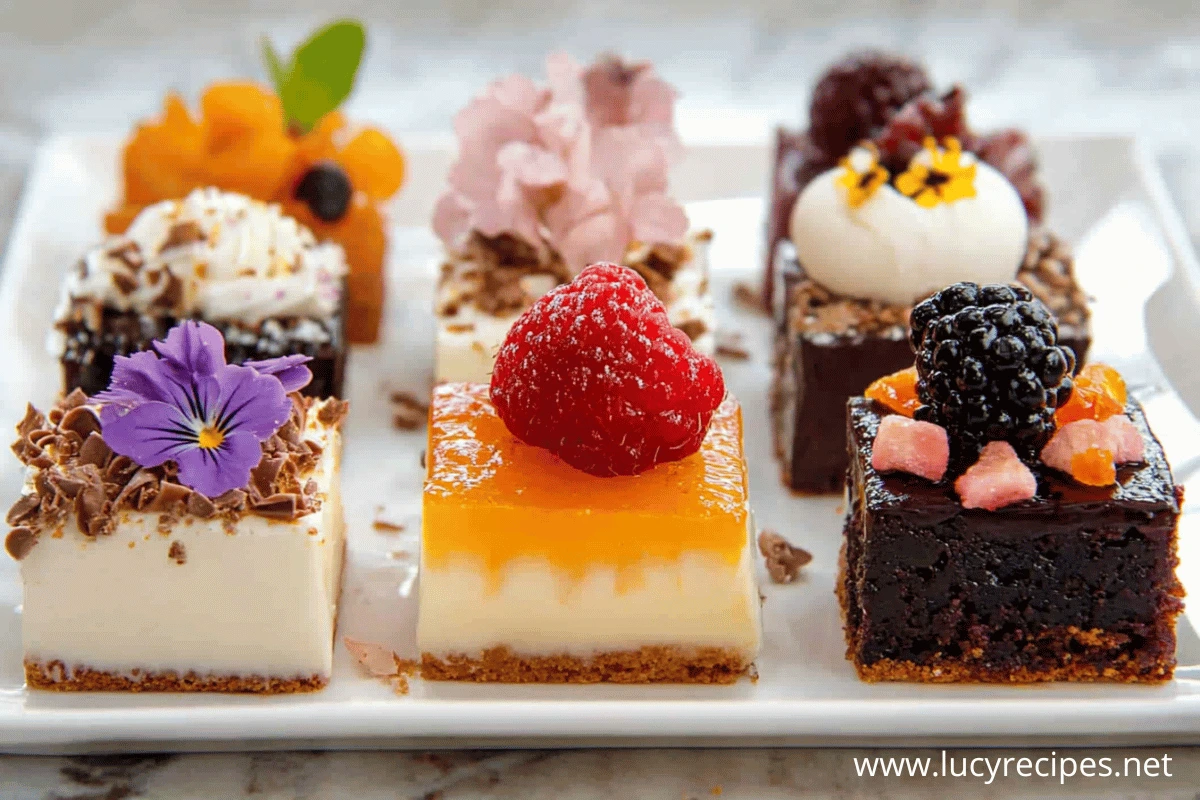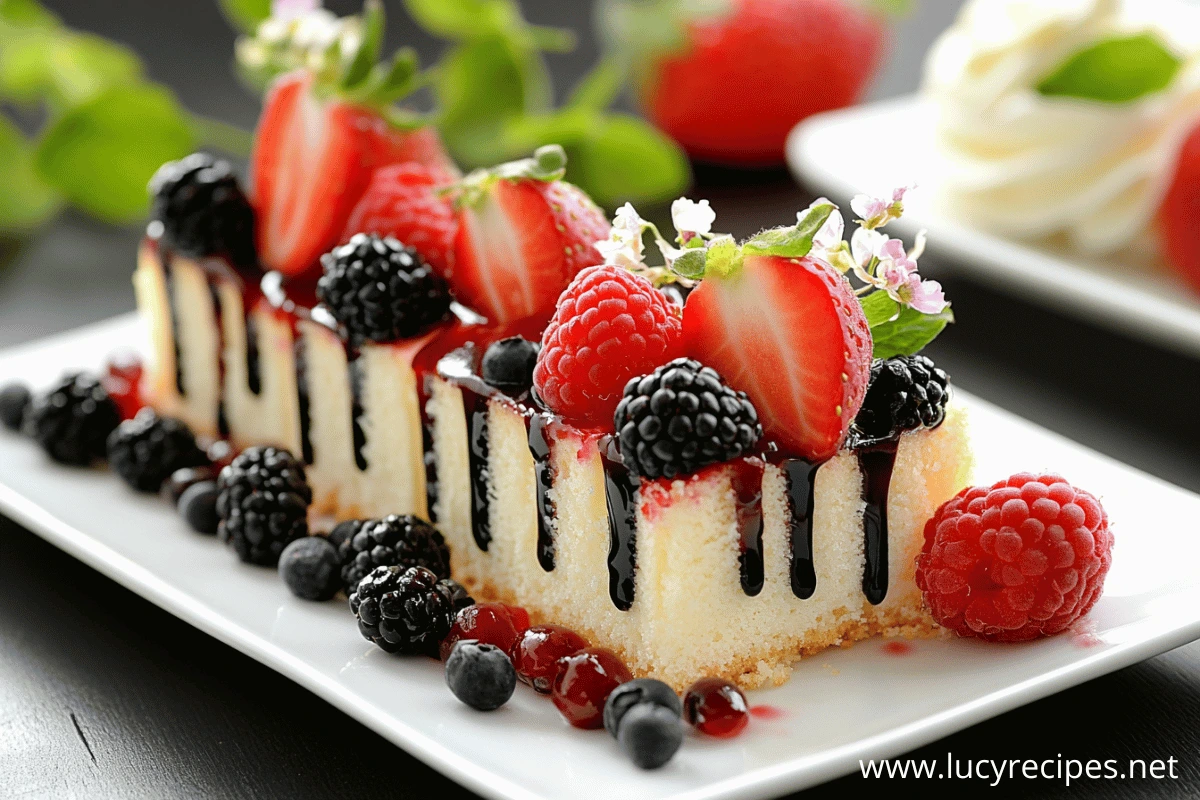Introduction
What is a poke cake?
A poke cake is a type of dessert that is both visually appealing and deliciously moist. These cakes get their name from the method of preparation: after baking, holes are poked into the cake’s surface, and flavorful liquids are poured over the top. This allows the liquid to seep into the cake, creating pockets of flavor and ensuring every bite is rich and satisfying. Poke cakes are often topped with whipped cream, frosting, or additional garnishes, making them versatile and customizable.
If you enjoy trying out different desserts, you might also like Pumpkin Caramel Poke Cake, a variation that’s both seasonal and indulgent.
Why are poke cakes popular?
Poke cakes have become a staple in many households and celebrations due to their ease of preparation and unique texture. Unlike traditional cakes, they offer a creative way to infuse flavor directly into the dessert. The ability to use various liquids, such as sweetened condensed milk, gelatin, or pudding, means the flavor combinations are virtually endless. Furthermore, their moistness makes them an excellent choice for people who enjoy a tender, melt-in-your-mouth texture. The vibrant fillings, such as a strawberry variation, not only enhance the flavor but also add visual appeal, much like the effect seen in Mini Pecan Tarts.
Table of Contents
Understanding Poke Cake Basics
Ingredients used in poke cakes
Creating a poke cake requires simple ingredients that are often pantry staples. The basic components include:
- Cake mix or homemade cake batter: Vanilla, chocolate, or any preferred flavor.
- Liquid filling: Options include sweetened condensed milk, flavored gelatin, or pudding.
- Toppings: Whipped cream, frosting, or fruit.
- Optional garnishes: Chocolate shavings, sprinkles, or chopped nuts.
These ingredients allow for endless customization, ensuring a poke cake suits any occasion or taste preference.
Typical preparation steps
Making a poke cake involves a few straightforward steps:
- Bake the cake: Use a store-bought mix or homemade recipe. Ensure the cake cools slightly before proceeding.
- Poke the holes: Use the handle of a wooden spoon or a skewer to create evenly spaced holes across the cake’s surface.
- Prepare the liquid filling: Mix gelatin, pudding, or other liquids according to package instructions.
- Pour the filling: Slowly pour the liquid over the cake, allowing it to seep into the holes.
- Chill the cake: Refrigerate the cake to let the filling set and enhance the flavor.
- Add toppings: Spread whipped cream, frosting, or other toppings over the cake before serving.
How Poke Cakes Absorb Liquids
The science behind soaking cakes
The key to a successful poke cake lies in its ability to absorb liquids effectively. When holes are poked into the cake, they create pathways for liquids to penetrate. The porous structure of the cake allows the liquid to travel through the crumb, creating a moist and flavorful interior. This process relies on the cake’s sponge-like quality, which ensures the liquid is evenly distributed.
Factors affecting liquid absorption
Several factors influence how well a poke cake absorbs liquids:
- Cake density: Lighter, spongier cakes tend to absorb liquids more effectively than dense cakes.
- Hole size and spacing: Larger or closely spaced holes allow for better liquid distribution.
- Type of liquid: Thinner liquids, like gelatin, seep more easily than thicker fillings like pudding.
- Pouring technique: Pouring slowly ensures the liquid penetrates the cake rather than pooling on the surface.
Understanding these factors helps create a perfectly moist cake without risking sogginess.
Common Liquids Used
Sweetened condensed milk
Sweetened condensed milk is a popular choice for poke cakes due to its rich and creamy texture. Its sweetness enhances the cake’s flavor while providing a smooth consistency that seeps evenly into the holes. It pairs particularly well with flavors like chocolate or coconut, creating a decadent dessert.
Gelatin and pudding
Flavored gelatin and pudding are equally favored for poke cakes. Gelatin adds vibrant color and a light texture, making it ideal for fruity cakes. Pudding, on the other hand, adds creaminess and works well with richer flavors like vanilla or caramel. Both options ensure a moist, flavorful cake that appeals to various preferences.
Do Poke Cakes Get Soggy?

Defining “soggy” in the context of desserts
In the realm of desserts, “soggy” refers to an overly wet texture that detracts from the enjoyment of the dish. A cake that is too moist may feel dense or unpleasantly mushy. However, the hallmark of a good poke cake is its ability to remain moist without crossing into soggy territory.
Balancing moisture for the best texture
To achieve the ideal balance, it’s crucial to control the amount of liquid used. Pouring too much filling or failing to let it absorb properly can lead to sogginess. By:
- Using the right liquid-to-cake ratio.
- Allowing sufficient chilling time.
- Ensuring the cake is not overbaked before adding liquid.
You can create a poke cake that retains its structure while delivering moist, flavorful bites.
Preventing Excess Sogginess
Tips for controlling liquid amounts
Preventing sogginess starts with managing the amount of liquid poured into the cake. Here are some tips:
- Measure carefully: Avoid overpouring by measuring the liquid beforehand.
- Layer gradually: Pour liquid in stages to allow for better absorption.
- Consider cake type: Dense cakes may require less liquid to avoid oversaturation.
Best cooling and chilling practices
Proper chilling is essential to prevent sogginess and enhance flavor:
- Cool the cake completely: Ensure the cake is at room temperature before adding liquid.
- Refrigerate overnight: This gives the liquid time to fully integrate into the cake.
- Cover tightly: Use plastic wrap or a lid to prevent the cake from drying out during chilling.
Benefits of Moist Poke Cakes
Enhanced flavor distribution
One of the biggest advantages of poke cakes is the even distribution of flavor. The liquid filling infuses every bite, ensuring a consistent taste throughout the dessert. This makes poke cakes an excellent choice for flavor-packed celebrations.
Longer shelf life compared to drier cakes
Moist cakes often have a longer shelf life because the liquid helps retain freshness. By keeping the cake tender and preventing it from drying out, poke cakes remain enjoyable for several days when stored properly. This makes them ideal for events where the dessert needs to be prepared in advance.
Popular Poke Cake Variations

Strawberry poke cake
Strawberry poke cake is a timeless classic that showcases the perfect harmony of fruity sweetness and moist texture. This variation involves poking holes in a vanilla or white cake and filling them with strawberry gelatin. The result is a visually stunning dessert with vibrant red streaks running through each slice. To elevate the flavor, consider topping the cake with whipped cream and fresh strawberries. While some may worry, do poke cakes get soggy?, carefully balancing the gelatin ensures this cake retains its delightful texture.
Chocolate fudge poke cake
For chocolate lovers, a chocolate fudge poke cake is undoubtedly the ultimate indulgence. Specifically, this version starts with a rich chocolate cake base that is filled with luscious chocolate pudding or fudge sauce. As a result, the decadent filling seeps into every bite, creating a velvety texture. To address concerns such as “do poke cakes get soggy?”, it is important to use a thick pudding mixture and refrigerate the cake overnight. Additionally, you can elevate its presentation by adding a layer of chocolate ganache or a sprinkle of decorative toppings for a polished finish.
Tres leches cake: A cultural cousin
Often considered a relative of poke cakes, tres leches cake hails from Latin America and shares the same principle of soaking. This cake is infused with a mixture of three milks: evaporated milk, condensed milk, and heavy cream. Though it’s known for being exceptionally moist, its structure prevents it from becoming soggy. If you’ve wondered, do poke cakes get soggy?, tres leches cake is proof that balance is key. Top it with whipped cream and a sprinkle of cinnamon for an authentic touch.
Storage Tips for Poke Cakes
Refrigeration best practices
Proper storage ensures your poke cake stays fresh and delicious for days. Always refrigerate poke cakes to maintain their texture and flavor. Use an airtight container or tightly wrap the cake with plastic wrap to prevent drying out or absorbing fridge odors. Ideally, refrigerate the cake within two hours of preparation. If you’re concerned about moisture levels, remember that careful chilling can address issues like do poke cakes get soggy? while preserving their appeal.
Freezing poke cakes without losing quality
Freezing is an excellent option for extending the shelf life of poke cakes. To freeze:
- Wrap individual slices or the entire cake in plastic wrap.
- Place the wrapped cake in a freezer-safe container or bag.
- Freeze for up to three months.
Thaw the cake in the refrigerator overnight before serving. This method minimizes the risk of excess moisture, ensuring that poke cakes don’t get soggy during storage.
How to Revive Overly Soggy Cakes
Techniques to salvage texture
If your poke cake becomes overly soggy, there are ways to restore its texture. Start by blotting excess liquid from the surface using paper towels. Another method is to lightly toast individual slices in the oven to evaporate some moisture. By addressing the common concern of do poke cakes get soggy?, these techniques can transform a potential disaster into a delicious dessert.
Creative ways to repurpose overly moist cakes
Overly moist poke cakes can be creatively repurposed rather than discarded. Consider turning them into cake pops by crumbling the cake, mixing it with frosting, and forming small balls. Alternatively, layer the soggy cake pieces with whipped cream and fruit to create a trifle. These solutions ensure no dessert goes to waste, even if you’ve wondered, do poke cakes get soggy?
Serving and Presentation Ideas

Creative toppings and garnishes
Elevate the presentation of your poke cake with imaginative toppings. Some ideas include:
- Fresh fruit or berries
- Chocolate shavings or drizzle
- Crushed cookies or nuts
- Edible flowers for a decorative touch
These garnishes not only enhance the cake’s visual appeal but also add complementary flavors. If concerns like do poke cakes get soggy? arise, remember that creative toppings can help mask minor imperfections.
Perfect pairings: drinks and sides
Poke cakes pair wonderfully with various beverages and sides. Serve them with:
- Coffee or tea for a classic combination
- Sparkling water infused with fruit for a refreshing contrast
- A scoop of ice cream for an indulgent treat
These pairings ensure your poke cake experience is both satisfying and memorable.
The History of Poke Cakes
Origin and evolution of poke cakes
Poke cakes first gained popularity in the 1970s as a creative way to enhance traditional cakes. Their rise coincided with the introduction of packaged gelatin and pudding mixes, which simplified the process. Over time, the concept evolved, incorporating diverse flavors and toppings. While their simplicity remains a draw, the question do poke cakes get soggy? has led to innovative techniques to perfect their texture.
Why they became a household favorite
Poke cakes are beloved not only for their versatility but also for their ease of preparation and impressive results. In addition, they cater to various tastes and occasions, ranging from casual family dinners to elaborate celebrations. What truly sets them apart from traditional cakes, however, is their unique method of infusing flavor, which ensures every bite is moist and flavorful. Furthermore, addressing concerns, such as whether poke cakes get soggy, has only added to their enduring popularity over time.
FAQs
What makes poke cakes unique?
Poke cakes stand out due to their method of infusing liquid into the cake, creating a moist and flavorful dessert. The combination of simplicity and creativity makes them a favorite for bakers and dessert lovers alike.
Can I use alternative liquids?
Yes, alternative liquids like fruit juices, syrups, or dairy-free milk can be used to suit dietary preferences or flavor profiles. Ensure the liquid complements the cake’s base flavor to avoid overwhelming the dessert.
How long do poke cakes last in the fridge?
Poke cakes typically last 3-5 days in the refrigerator when stored in an airtight container. Proper chilling prevents spoilage and addresses concerns like do poke cakes get soggy?
What’s the difference between moist and soggy?
Moist cakes have a tender, flavorful crumb, while soggy cakes are overly wet and dense. Striking the right balance ensures a delightful texture without compromising the cake’s structure.
Can poke cakes be made gluten-free?
Yes, using gluten-free cake mixes and thickeners for fillings allows for delicious gluten-free poke cakes. Ensure all ingredients are certified gluten-free for best results.
Is it safe to leave poke cakes at room temperature?
Poke cakes should not be left at room temperature for more than two hours, especially if they contain dairy-based fillings. Refrigeration is key to preserving their quality and safety.
Conclusion
Summarizing key points
Poke cakes are a delightful dessert that seamlessly combines simplicity, flavor, and creativity. Moreover, by addressing common concerns, such as whether poke cakes get soggy, you can achieve the perfect balance of moisture and texture. Furthermore, with endless variations to explore and proper storage techniques to follow, poke cakes continue to be a versatile and cherished treat for any occasion.
Encouragement to try poke cakes
Whether you’re a seasoned baker or new to the kitchen, poke cakes are an excellent choice for experimenting with flavors and techniques. Their forgiving nature ensures success, making them a must-try dessert for any occasion.

